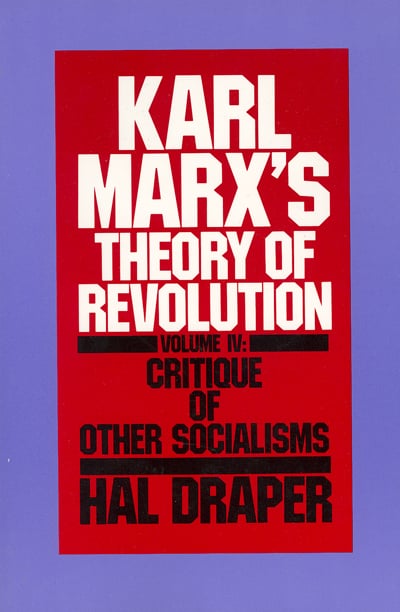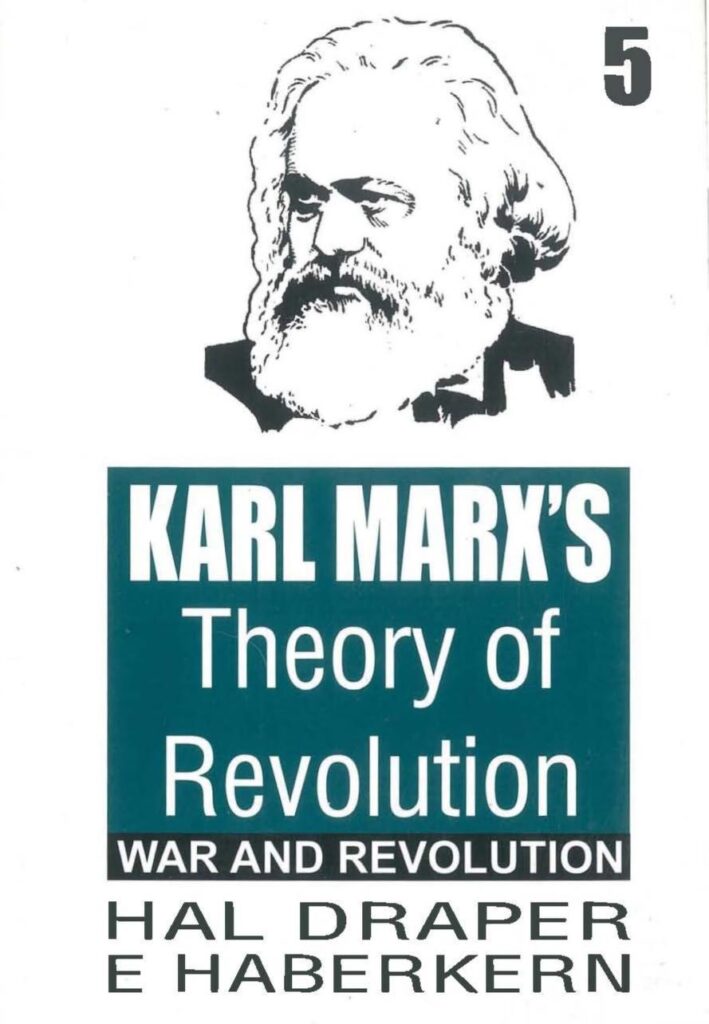Biblioteca / 1970-1979 2000-2009
Hal Draper. Karl Marx’s Theory of Revolution.
Nueva York: Monthly Review Press, 1977/78/86/90/2005.
Nueva Delhi: Aakar Books, 2011.
5 volúmenes: 730+740+440+365+275 páginas.
Hal Draper (1914-1990)
CONTENTS
Volume I
STATE AND BUREAUCRACY
BOOK I
Foreword
PART I
THE POLITICAL DEVELOPMENT OF THE YOUNG MARX
1 – The Democratic Extremist
2 -The Political Apprentice
3 – Emancipation from Hegel
4 – The New Direction
5 – Implementing the New Direction
6 – Orientation Toward the Proletariat
7 – Toward a Theory of the Proletariat
8 – Toward a Class Theory of the State
9 – Character and Revolution
10 – Toward the Principle of Self-Emancipation
PART II
THE THEORY OF THE STATE
11 – The State and Society
12 – The State in Practice: Methods and Forms
13 – The State and Democratic Forms
14 – The Tendency Toward State Autonomy
BOOK II
15 – The Bonaparte Model
16 – Bonapartism: The Bismarckian Extension
17 – Bonapartism and the “Progressive Despot”
18 – Bonapartism in Extremis
19 – State Autonomy in Precapitalist Society
20 – State Bureaucracy and Class
21 – Oriental Despotism: The Social Basis
22 – Oriental Despotism: State and Bureaucracy
23 – Russian Czarism: State and Bureaucracy
APPENDICES
Special Note A. Marx and the Economic-Jew Stereotype
Special Note B. Rhyme and Reason: The Content of Marx’s Juvenile Verse
Special Note C. The State as Political Superstructure: Marx on Mazzini
Special Note D. The “State Parasite” and the “Capitalist Vermin”
Special Note E. Oriental Despotism Before Marx: the Wittfogel Fable
Special Note F. Oriental Despotism and Engels
Reference Notes
Bibliography
___________
Volume II
THE POLITICS OF SOCIAL CLASSES
Foreword
PART I
THE PROLETARIAT AND PROLETARIAN REVOLUTION
1 – Patterns of Revolution
2 – The Special Class
3 – Anatomy of the Proletariat
4 – Trade Unions and Class
5 – Trade Unions and Politics
6 – The Principle of Class Self-Emancipation
PART II
SOCIAL CLASSES IN REVOLUTION
7 – The Bourgeoisie and Bourgeois Revolution
8 – Permanent Revolution in 1848
9 – Permanent Revolution: Final Version
10 – Bourgeois and Proletarian Revolution: Balance Sheet
11 – The Petty-Bourgeoisie in Revolution
12 – The Peasant Question: Social Setting
13 – The Peasant Question: Toward a Revolutionary Alliance
14 – The Peasant Question: Programmatic Problems
15 – The Lumpen-Class Versus the Proletariat
PART III
MIXED-CLASS ELEMENTS
16 – Intellectual Labor and Laborers
17 – The Social Role of Intellectual Elements
18 – Intellectuals and the Proletarian Movement
APPENDICES
Special Note A. Marx on the Abolition of the Proletariat by Automation
Special Note B. Marx’s Conversation with Hamann
Special Note C. Permanent Revolution: On the Origin of the Term
Special Note D. Hair! or, Marxism and Pilosity
Special Note E. The Address to the Communist League of March 1850
Special Note F. The Alleged Theory of the Disappearance of the Middle Classes
Special Note G. On the Origin of the Term Lumpenproletariat
Special Note H. Two Adventures in Sophisticated Marxology
Special Note I. The Weitling Myth: Horny-Handed Proletarian vs. Intellectual
Special Note J. Marx’s Course in April-May 1848
Reference Notes
Bibliography
___________
Volume III
THE DICTATORSHIP OF THE PROLETARIAT
Foreword
PART I
DICTATORSHIP: ITS MEANING IN 1850
1 – From Rome to Robespierre
2 – Socialism and Dictatorship: The Beginning
3 – Dictatorship in 1848
4 – The Dictatorship of the Democracy: Marx in 1848
5 – The “Dictatorship of the People”: Conservative Version
PART II
THE TERM ‘DICTATORSHIP’ IN MARX AND ENGELS
6 – The Spectrum of ‘Dictatorship’
7 – Some Dictators over the Proletariat
PART III
PRELIMINARIES: THE “MARX-BLANQUIST” MYTH
8 – Introduction to the Investigation
9 – Marx and Blanqui
10 – Marx Versus Blanquism
PART IV
‘DICTATORSHIP OF THE PROLETARIAT’ IN MARX AND ENGELS
11 – Marx’s Class Struggles in France
12 – The SUCR Episode
13 – Reverberations in 1850: The NDZ Exchange
14 – More Reverberations
15 – From Weydemeyer to Vogt
16 – The Many Dictatorships of Moses Hess
17 – The Second Period of the ‘Dictatorship of the Proletariat’
18 – Marx and the Blanquists After the Commune
19 – Marx and Engels in the Second Period
20 – The Third Period of the Dictatorship of the Proletariat’
SPECIAL NOTES
A – Marxologists at Work
B – Fabrication of a Fable: The “Marx-Blanquist” Myth
C – The Meaning of ‘Terror’ and ‘Terrorism’
D – Ghosts, Goblins, and Garbles
E – Marx-Engels Loci: Summary List
Reference Notes
Bibliography
___________
Volume IV
CRITIQUE OF OTHER SOCIALISMS
Foreword
1 – Of Utopian Socialism
2 – Of Sentimental Socialism
3 – Of State-Socialism: Lassallean Model
4 – Of State-Socialism: Bismarckian Model
5 – Of Anarchism: Proudhonist Model
6 – Of Anarchism: Bakunin Model
7 – Of the Reactionary Anticapitalisms
8 – Of Boulangism: The Politics of the Third Way
APPENDICES
Special Note A. Lassalle and Marx: History of a Myth
Special Note B. Bakunin and the International: A “Libertarian” Fable
Special Note C. The Strange Case of Franz Mehring
Reference Notes
Bibliography
___________
Volume V
WAR AND REVOLUTION
INTRODUCTION
1 – WAR AND THE DEMOCRACY IN 1848
2 – “NON-HISTORIC” PEOPLES
3 – THE SIXTH POWER
4 – PULLING THE PLUG
5 – “THE DESPOTS OF ALL COUNTRIES ARE OUR ENEMIES”
6 – BURYING THE ‘TSARIST MENACE’
7 – BURNING DOWN THE EMPEROR’S PALACE
SPECIAL NOTE A. ROSDOLSKY VS. ROSDOLSKY
SPECIAL NOTE B. “CONSTITUTIONAL” OR “REVOLUTIONARY” WAR?
SPECIAL NOTE C. THE LINCOLN MYTH
SPECIAL NOTE D. ENGELS’ “LAST TESTAMENT” A TRAGI-COMEDY IN FIVE ACT
BIBLIOGRAPHY




